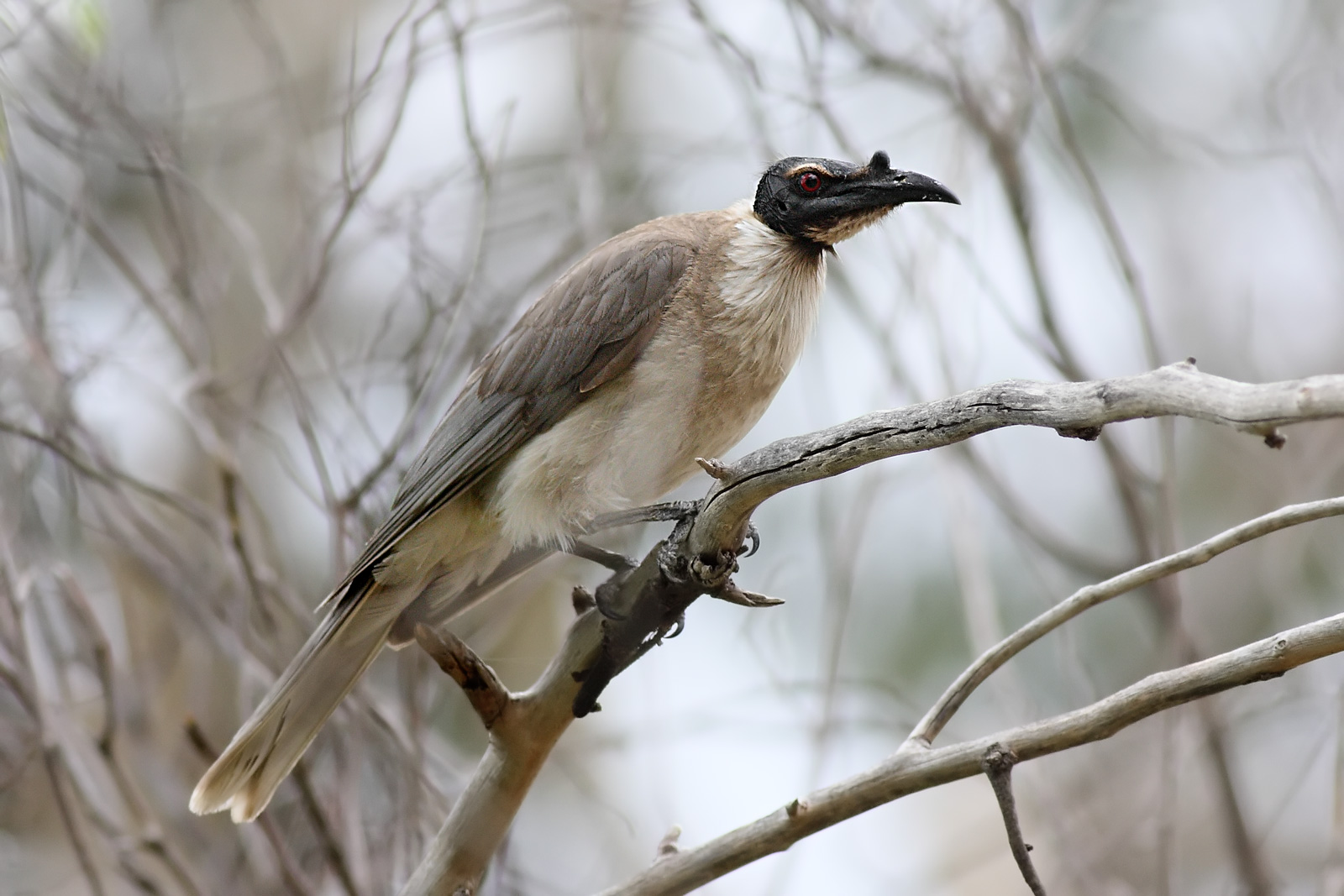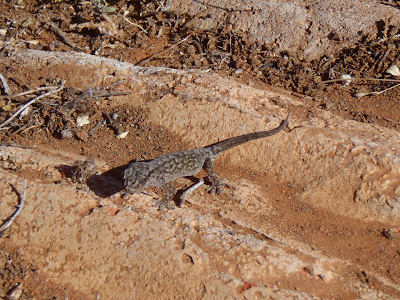Post title blog pager
Sunday, May 27, 2012
#199 Painted Dragon
Ctenophorus pictus
IUCN Redlist: Not Evaluated
Location: Pamamaroo Lake, NSW, Australia
Time: 1440 AEST May 2, 2012
Random Invertebrate Day #6 Cnidarians
Next up is a sea nettle, Chrysaora fuscescens, taken from the Bamfield dock. This one was in the vanguard of a great swarm of sea nettles. The day I took this photo I only saw 2 or 3 sea nettles in the inlet - by the next morning, and for a week or so after, there were thousands of them.
Above is a stalked jellyfish, a member of the Stauromedusae, found in the intertidal in Victoria, BC. Although it seems to bear more resemblance to an anemone, it is actually a jellyfish that has turned upside down, and attached to the substrate at the top of its bell.
The stalked jellyfish have typically been included within the class Scyphozoa, together with the "true" jellyfish like the sea nettle above. Anemones are members of the Anthozoa, together with corals; other classes include the Cubozoa, or box jellyfish, Hydrozoa, and the parasitic classes Myxozoa and Polypodiozoa, though the evolutionary affinities of the last two have been the subject of some debate, and the matter is not yet settled.
The stalked jellyfish have typically been included within the class Scyphozoa, together with the "true" jellyfish like the sea nettle above. Anemones are members of the Anthozoa, together with corals; other classes include the Cubozoa, or box jellyfish, Hydrozoa, and the parasitic classes Myxozoa and Polypodiozoa, though the evolutionary affinities of the last two have been the subject of some debate, and the matter is not yet settled.
And finally, here is a series of photos of anemones living on the underside of the Bamfield dock.
In the photo below you can also see some members of another class, the Hydrozoa. The feathery, plant-like structures in the upper left part of the photo are hydroids, a colonial form of cnidarians. Small anemone-like polyps build a home of chitin and proteins, and are joined by tubelike structures called hydrocauli.
Sunday, May 20, 2012
#198 Whistling Kite
IUCN Redlist: Least Concern
Location: Pamamaroo Lake, NSW, Australia
Time: 1410 AEST May 2, 2012
Random Invertebrate Day #5 Mexican Butterflies
This next butterfly was also in Oaxaca, outside the Panteon General, the main cemetery, which we visited on El Dia de los Muertos, the Day of the Dead, November 1st 2011.
The next two were in Mazunte, a small town on the pacific coast of Oaxaca state.
Above is a butterfly from Lake Catemaco, in the south of Veracruz state, and below are two sitting on the ruins of El Tajin, in the northern part of the same state.
#197 White-necked Heron
Ardea pacifica
IUCN Redlist: Least Concern
Location: Pamamaroo Lake, NSW, Australia
Time: 1410 AEST May 2, 2012
#196 Australian Raven
Corvus coronoides
IUCN Redlist: Least Concern
Location: Pamamaroo Lake, NSW, Australia
Time: 1400 AEST May 2, 2012
There are 5 resident species of Corvus in Australia, all of which are all-black with a white iris, three of which live around the Menindee Lakes in New South Wales, and the easiest way to tell them apart is by their calls. The call of the Australian raven, as described in the Simpson & Day Field Guide to the Birds of Australia, is a series of slow 'aaaa...' notes with a strangled, drawn out finish. They can sound quite human-like, like an upset child.
IUCN Redlist: Least Concern
Location: Pamamaroo Lake, NSW, Australia
Time: 1400 AEST May 2, 2012
Wednesday, May 16, 2012
Random Invertebrate Day #4: Mexican Caterpillars
The rest are all from Lake Catemaco, in Veracruz State. Click on all pictures for a larger version.
I got this next one on video, as it was moving in an unusual way, pausing frequently to waggle both ends of its body
I suspect it might be a form of mimicry, copying the action of looking around with the fake head on its rear end.
Tuesday, May 15, 2012
#195 Noisy Friarbird
Philemon corniculatus
IUCN Redlist: Least Concern
Location: Menindee, NSW, Australia
Time: 1230 AEST May 2, 2012
I wasn't going to post this because of the quality of the photos, but the friarbirds are just such weird-looking birds, I couldn't resist. In the photo below you can see a magpie-lark, one of a pair that the friarbird was harassing, though they were fairly unperturbed by it.
In addition to having a darker head, and that dark throat-band, the noisy friarbird can also be distinguished from the little friarbird, the other species found around Menindee, by its red eye, which you can just make out in the photo below.
Here's a much better picture from wikimedia commons, by Fir0002/Flagstaffotos.
The original can be found here, and it has been made available under the GNU Free Documentation License, a copy of which can be found here.
Monday, May 14, 2012
Random Invertebrate Day #3: Leeches
Leeches have also been in the news lately, as a recent paper has demonstrated their utility in monitoring mammal species in dense forests. This is one more valuable tool in the often desperate field of conservation biology.
I have embedded a video of the leech looping its way across the moss. It's pretty blurry, but if you look at the left hand side of the screen between 2 and 5 seconds, you can see a cool little mite or something scurry along and then disappearing into a crack. These miniature forests and their inhabitants are so fascinating.
Saturday, May 12, 2012
#194 Emu
Dromaius novaehollandiae
IUCN Redlist: Least Concern
Location: Menindee, NSW, Australia
Time: 1130 AEST May 2nd, 2012
#193 Tree Dtella
Gehyra variegata
IUCN Redlist: Least Concern
Location: Yancowinna County, NSW, Australia
Time: 1000 ACST May 2nd, 2012
#192 Little Corella
Cacatua sanguinea
IUCN Redlist: Least Concern
Location: Broken Hill, NSW, Australia
Time: 1710 ACST April 30th, 2012
Little corellas flocked above Broken Hill in the hundreds every evening, but they were very elusive when a camera was involved.
Thursday, May 10, 2012
Random Invertebrate Day #2
The technique was pretty much to flash wildly as things flew by, so I mostly got nothing, but a few like these turned out ok.
Tuesday, May 1, 2012
Random Invertebrate Day #1 Sweat Bees
Since I have a lot of pictures of invertebrates, I've decided to post some of them in a new feature, the Random Invertebrate Day. To be clear, it's the day that is random, not the invertebrate. The days have been selected using the random number generator on Google Docs, so I guess it's probably actually the Pseudorandom Invertebrate Day. There's a 1-in-7 chance of any day being selected.
Subscribe to:
Posts (Atom)











































